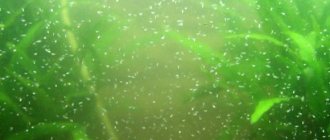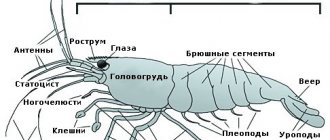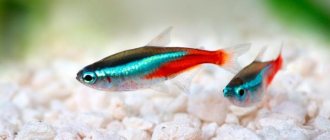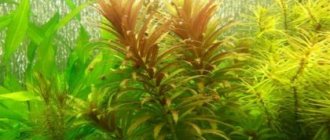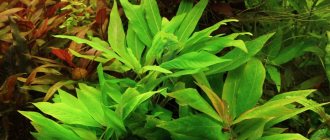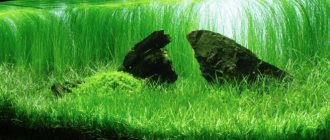Vallisneria is considered the most unpretentious and popular type of aquarium algae. The plant has excellent decorative qualities, it is undemanding in care and gets along well with other varieties of algae. Vallisneria is also called Elodea or Cryptocoryne and belongs to the Aquiaceae family, which is native to tropical and subtropical waters.
Vallisneria is considered the most unpretentious and popular type of aquarium algae.
Description
Vallisneria is a perennial aquatic plant from the aquaticaceae family. Grows in the tropics, subtropics and temperate latitudes.
American Vallisneria in natural conditions
The plant is adapted to life in rivers and lakes, in flowing and standing reservoirs, in fresh and brackish water. It is found both in shaded areas and in areas exposed to the sun. For the survival of Vallisneria, only 2 conditions are important: the constancy of the reservoir (as a truly aquatic plant, Vallisneria will die if it dries out) and shallow depth.
Vallisneria grows in bushes, has a shortened stem and ribbon-shaped leaves, reaching a length of up to 100 cm. It looks equally beautiful in high aquariums and shallow ones, where the plant spreads along the surface of the water.
Where does it live?
The Vallisneria plant originally lived in the subtropics and hot tropics, but today it can be found in the temperate zone. It is widely found in China, Iraq, Korea, Japan, the Philippines, India, and Honduras.
This species has adapted well to river flows and stagnant lake waters, but prefers slow-moving streams, where it germinates at a depth of up to 4 meters.
In Russia it is found on the Volga, Lower Don, and Far East. Today, Vallisneria is gaining popularity among landscape designers for creating artificial ponds.
Popular types
There are 14 species of Vallisneria, but this figure is unstable. Quite often, scientists revise the classification. Only two species remain unchanged - spiral and American Vallisneria. Changes constantly occur with the rest, this is due to the similarity of most species and forms, and the fact that the appearance of Vallisneria is determined by its living conditions.
There are 5 common plant species in the aquarium hobby.
Spiral Vallisneria
Vallisneria spiralis linne got its name not because of the curled leaves, all Vallisneria have them to one degree or another, but because of the spiral of the peduncle of the female flower. Grows in the tropics and subtropics. It has light or juicy green leaves up to 80 cm long and 0.4-0.8 cm wide.
American Vallisneria
Vallisneria americana is distributed in North and Central America and South Asia. It has soft, brittle, ribbon-shaped leaves with jagged edges, green in color with slight red splashes. The leaves reach 40 cm in length and 2 cm in width.
Giant Vallisneria
Vallisneria gigantea is a large plant with bright or dark green leaves. Smooth linear leaves reach a length of 1.5 meters and a width of 4 cm. In nature, it is found on the islands of southeast Asia.
Dwarf Vallisneria
Vallisneria nana is distinguished by thin, thread-like leaves. The plant is dark green in color and reaches a height of 30 to 60 cm. It takes the longest to adapt to the aquarium of all species. In nature, dwarf Vallisneria is common in the waters of Northern Australia.
Twisted-leaved Vallisneria
Vallisneria spiralis f. tortifolia has strongly curled leaves along its entire length with jagged edges. The plant is dark green in color, the leaves reach a length of 40 cm and a width of no more than 1 cm.
Maintenance and care
Vallisneria actively produces oxygen and acts as a filter in the aquarium - it neutralizes nitrates, nitrites, phosphates and nitrogenous compounds. It is only afraid of excess copper and rust, which get into the tank during water changes or with medications for treating fish.
Despite its decorative and aquarium-positive qualities, Vallisneria is an unpretentious plant. Adapts to different conditions, only the size of the plant and color saturation will suffer.
Recommendations for keeping different types of plants are similar in many respects (there are minor differences, which are described in detail in the table):
| Options | View | ||||
| Spiral | American | Nana | Twisted leaf | Gigantic | |
| Aquarium | Medium to large tank | Only a large aquarium is suitable | |||
| Water temperature, °C | 20-28 | 20-28 | 25-28 | 22-28 | 20-26 |
| Acidity, pH | Neutral or slightly acidic environment | 6,5-8 | 6-8,5 | 6,5-8 | Soft, slightly acidic environment |
| Hardness, dH | Not higher than 8 | 5-15 | 5-15 | 5-15 | Less than 8 |
| Lighting | Medium, preferably natural light | Bright 12 hour | Moderate to bright | Bright lighting | Intensive, top and side 12 hour lighting |
| Priming | Fine soil, 4 cm thick | Sandy soil, 7 cm thick | Sand, layer 3-4 cm | Sand, fine gravel with a layer of 5 cm | Large pebbles or sand, at least 8 cm thick |
Since Vallisneria grows and multiplies very quickly, you definitely need to thin it out.
It is impossible to cut the leaves of Vallisneria - in the places where it is cut the plant turns yellow and begins to rot. Vallisneria that has grown too large is thinned out by removing the bushes along with the roots. Do this carefully, cutting off the tendrils on both sides of the plant.
How to plant a plant in an aquarium
For planting, choose young shoots of Vallisneria, they will take root better. The leaves should be bright and fresh, without damaged areas. Pay attention to the roots too - healthy roots are white, elastic, 5-10 cm long.
Plant the plant on the sides of the aquarium or against the back wall. Vallisneria grows very quickly, forming a green wall. You can plant dwarf Vallisneria in the center of the tank.
Rules for planting Vallisneria:
- Before planting, rinse the plant with warm water. You can also rinse Vallisneria for 5 minutes in a slightly salted solution (1 teaspoon of table salt per liter of water). This is done to remove harmful organisms that may enter the aquarium along with the plant.
- Make a small hole in the soil and place the plant. Straighten the roots so that they do not bend.
- Fill with soil, without compacting it too much, so as not to damage the root system. Please ensure that the growth bud remains on the surface of the substrate.
If Vallisneria is planted correctly, it quickly takes root, grows and multiplies.
Hornwort. Nayas. Elodea.
Let's start with plants that either do not have a root system at all, or those that, in general, do not really need roots. In old literature they were combined into the group “Plants floating in the water column.” These are primarily hornworts (light green Ceratophyllum submersum and dark green C. demersum), najas (primarily Guadelupe Najas guadelupensis = N.microdon) and “elodea” (a collective name for several species, the main of which are Egeria densa and Egeria najas ).
hornworts as starter plants when starting a new aquarium. They are so unpretentious that they can live in almost any water, with any hardness, pH and temperature. In nature, hornwort is found everywhere, from subarctic reservoirs to equatorial ones, including mountain lakes and brackish river estuaries. Hornwort does not form roots, so it is either left floating or fixed in the ground with various devices (arms, pins, weights). At the market and in pet stores, plastic rings with suction cups are sometimes sold - you can pass a bunch of hornwort through such a ring and attach it with a suction cup to the glass of the aquarium somewhere behind a snag or stone, so that the hornwort grows beautifully from behind the decoration. In addition to the light green and dark green hornworts already mentioned above, two more species are found in aquariums - Cuban and red-stemmed (from our Far East). And in total there are more than 50 species of them on earth. Hornwort propagates extremely simply - it branches easily, and any branch that falls off forms a new plant. The only drawback of hornwort (and its main advantage) is its very rapid growth. Hornwort is capable of absorbing nutrients from water with all its parts, and processing them into its tissues at such a speed that it is ahead of even filamentous algae in this process, taking away their “bread”. This growth rate requires a significant amount of nitrate nitrogen as a nutrient, and therefore hornwort effectively purifies water from excess nitrates and organic matter. And this determines the second popular use of hornwort - as a natural “algaecide” that helps cope with algae invasions in the aquarium and normalize the nitrogen cycle.
Hornwort dark green Hornwort light green Naiad Guadalupe Elodea densa Elodea Naiad Lagarosiphon large
Guadelupe najas in the same capacity (as a starter plant and as a natural algaecide) . Unlike hornwort, nayas has roots, and if it is planted in the ground, its branches take root normally. But in general, it doesn’t really need roots: the growth and development of nayas is almost not affected by the form in which it is grown - free-floating or rooted. Even a small branch of nayas, in good conditions, can grow in a month into a dense, branchy green bush, occupying half of the aquarium. It is an ideal spawning substrate for many simple fish species that form self-sustaining populations. Microrasboras “Galaxy”, common cardinals, etc. love to spawn in the thickets of nayas. This is also an excellent place for fry of viviparous fish - guppies, swordtails, platies - in order to hide from their voracious parents. Nayas have one drawback: once you have it in an aquarium, it is quite difficult to completely get rid of it. The stems of nayas actively branch and intertwine, and at the same time are quite fragile. When you remove it from the aquarium, several pieces will inevitably break off and “hide” among other plants, and after just a few days they will germinate and produce new young plants.
the Canadian elodea (Egeria canadiensis) was nicknamed the “water plague” in European countries, where it came from North America in the century before last. This beautiful and even elegant plant, having arrived on a new continent where there are not so many animals feeding on it, began to multiply uncontrollably, filling all standing and slow-flowing reservoirs in record time. Over time, nature’s protective mechanisms turned on, Elodea integrated into European ecosystems and ceased to pose a great threat to shipping, but it is still one of the most common aquatic plants, including in our country.
Cultural lines of “ elodea ” (Egeria densa, Egeria najas, Lagarosiphon major, etc.), grown in aquariums, do not come from the natural Canadian form introduced here, adapted to cold water, but from plants of tropical regions. Unlike the domestic Elodea “from a puddle”, the store-bought one is perfectly adapted to the warm water of our aquariums, and can well be recommended to beginning aquarists as a simple and unpretentious supplier of oxygen to fish and pleasure to the eyes. Elodea can be grown as a floating plant, but it is better to plant it in the ground, where it quickly and readily takes root. Elodea reproduces in the same way as most long-stemmed plants - by shoots broken off from the mother plant, which easily take root in the ground. Elodea blooms very rarely in nature, but in an aquarium it is completely “too lazy” to do so. Elodea are rarely used in aquarium design, but in vain! This is a beautiful side plant, forming very pretty bushes on the sides of the main composition of the aquarium.
Reproduction
Vallisneria reproduces vegetatively or by seed. Seed propagation at home is difficult. Since the plants are bisexual, it is necessary to plant male and female specimens side by side for pollination. In aquariums, most female specimens are found. The flowering time must also coincide. Some time after pollination, seed pods form on the female plant, which then fall into the water.
The image shows a flowering Vallisneria with a “baby” (on the ground), which can be detached and planted as an independent bush.
In an aquarium, it is best to propagate plants vegetatively. Up to 50-60 children are formed on the mother plant per year. When 3-4 leaves form on the daughter plant and roots develop, carefully separate the baby and plant it in the ground.
Why doesn't Vallisneria grow?
Vallisneria is one of the most unpretentious aquarium plants, but it happens that it does not take root or grows poorly. This happens due to a number of factors that negatively affect plants:
- lack of lighting;
- cold water temperature - 15 °C or less;
- insufficient nutrient content, infrequent feeding;
- copper and rust content in water;
- too rare or frequent water changes, use of unsettled water;
- the presence of nearby plants with a powerful root system that reduce the nutrition of Vallisneria.
Diseases
Vallisneria diseases are often associated with a lack of lighting and certain chemicals. If the necessary measures are not taken, she will soon die. A sick plant's appearance becomes distorted and it begins to turn yellow. First of all, you need to remove the diseased parts of the algae with tweezers. The presence of many diseases is easily prevented by regular cleaning. The most common causes of Vallisneria disease include:
- low lighting, in which the algae loses its color and the lower leaves fall off. To eliminate this problem, it is necessary to organize more powerful lighting;
- low temperature, at which algae seem to “freeze” and die;
- Lack of iron leads to yellowing of the algae, which seems to “glaze over.” If you add 0.1 mg to the aquarium every 7 days. iron sulfate, a brighter plant is obtained;
- with an excess of iron, yellowness appears with persistent green streaks. Excess iron is eliminated with a small amount of dissolved manganese;
- Lack of calcium affects the yellowed edge of the leaf. To eliminate this problem, you should first place a disinfected sink in the aquarium;
- lack of nitrogen manifests itself in premature death of leaves. To create the necessary balance, you should lower the water temperature by 2-3 degrees;
- when the leaves are covered with lime, this indicates a lack of carbon dioxide. You can help the plant by purchasing several aquarium inhabitants;
- if the leaves change their usual color to a reddish color, then this indicates a lack of sulfur. In this case, you should plant the algae separately with 1 speck of sulfur dissolved;
- when the leaves become covered with yellow and brown spots, it can be assumed that there is a lack of potassium, which should be eliminated by applying mineral fertilizers during a water change.
Advice: When choosing Vallisneria as an aquarium plant, you should pay attention to the fish kept, since there are species that dig the soil, thereby leading to damage to the algae.
Vallisneria is an excellent plant that lives in home aquariums; it is perfect for beginners due to its unpretentiousness.
